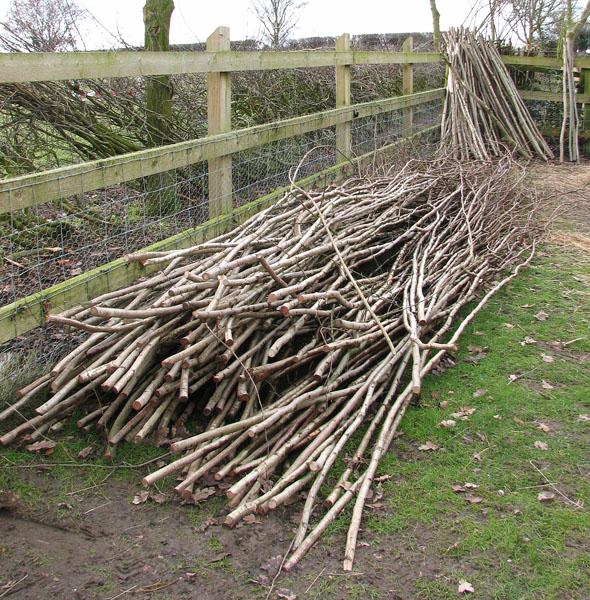When considering fencing, points to look at are:
- What it is for
- Money available
- Appearance
- Area to be fenced
Stock fencing
Fit fencing to keep stock in or out with small spaces at bottom. Cattle can be restrained with 2 or 3 strands of well strained barbed wire but this is unsightly, difficult to use and not very environmentally friendly – stockproof hedging is a better option; sheep and goats require netting to a reasonable height, whilst it is vital that horses have a very visible fence. Free range pigs need substantial heavy mesh buried deep in the ground. Free range hens need 6′ mesh fence to keep predators out and deer also need that height.
Footpaths/right of way
Allow for rights of way, footpaths, etc., or fences will get broken down by walkers. Gates are better than stiles as some walkers will pull a fence up to let their dog through; of course the disadvantage is that they will leave gates open.
Tools
Fork, scythe and slasher to clear the ground. Spade for digging holes, crowbar to insert before driving stakes home with a sledge hammer or preferably a post rammer/driver (the sledge hammer can split the wood). Saw, pliers, hand hammer, nails, staples and wire tightener.
A home made wire strainer can be made from 90cm (3′) length of metal pipe. Make a saw cut across diameter at one end to depth of 7cm (3″), wide enough to admit wire. Pipe used as a lever against posts to stretch wire tight then secure wire with staples.
Setting fence line
For boundary fences it is important to get the line right. A well set fence can last for years.
Set the line dead straight as far as possible. Direction changes cause weaknesses as they tend to pull over the uprights. Clear away bushes, undergrowth and overhanging branches. If ground slopes steeply, a straight line is even more important.
Techniques
Before starting on the fences themselves, a few notes about techniques:
Digging post holes
A post hole less than 60cm (24″) deep results in a wobbly fence. A hole 17–26cm (7 or 9″) square is practical and causes least work. It is also easier to repack the soil in a smaller hole tightly. Make square holes even for round posts because the most useful tool for digging post holes is a small flat spade – lady’s type 12.5cm (5″ wide) as the man’s spade is too wide. Choose a time when the ground is not too hard to drive in the posts.
Remove the spoil as you dig, ideally into a wheelbarrow which can be covered if there is a sudden shower. A small pan and a small narrow trowel are helpful when removing the debris after the first few inches.
Keep the walls as vertical as possible but the hole can taper in a little at the bottom to save time. Get rid of large stones as they cause more problems than they solve when backfilling.
Place the post centrally in the hole. Keep the post upright and add two or three shovelfuls of backfill and tamp well down. Keep adding a couple of shovels at a time, tamping down between each addition and making sure post has not moved from upright up to ground level.
Another way to make post holes is to use a crowbar-shaped bar 4cm (1½”) diameter, 1.5m (5′) long, with one end chisel pointed and the other end thickened for tamping down. Spear bar into ground and rotate on its point until required depth is reached. (note you could mark depths on bar). This gives a conical hole and the surrounding soil is compacted rather than removed so it gives a firm seat for the post. Space round the top can be filled with stones.
End and corner posts
Set end or corner posts well. Depth of 75cm (2’6″) best and posts need to be 15cm (6″) square. Big branches are suitable if straight and they don’t need to be sawn.
A nick is made in face of post, high up in direction of fence. The lever or strainer is inserted, the lower end being dug into ground and faced onto a big stone. This is done at either end and at any changes in direction.
Straining wires
Setting up the straining posts and straining the wire is half the battle. Once properly done the rest is comparatively easy. Stakes are needed every 300cm (10′) or so using a piece of wood of the exact length. A fence with unevenly spaced stakes looks amateurish.
Each strand of wire on the straining posts must be securely fixed with 2 or 3 staples driven home. On the intermediates fewer are needed.
Driving in and finishing off
When driving in intermediate stakes, a hole is made first with a pointed crowbar. Then stake tapped lightly in ensuring it is upright till it grips. An assistant keeps it upright by pressing on it with a square ended board, keeping hands well clear of the driving mallet.
Finally saw off the top of the stakes to an even height using a sharp saw so stakes are not disturbed. Tidy all brushwood away together with tools and bits of wire.
It is possible to buy wire tighteners which should be tightened yearly but they are often neglected and then are too rusty to move.
Changes of height
For changes of height an extra stake is often needed. It is driven into a low place and the fence sloped down to it or on a bulge, it lifts fence to required height.
Preserving
Stakes are best creosoted under pressure and this is done by boiling them in a barrel of creosote and allowing them to cool before repeating process.
A ‘roven’ stake lasts longer than a sawn one. The former is produced by splitting a length of timber with wedges into appropriate thicknesses then sharpening the ends. Roven oak stakes will last a lifetime. Ash rots at ground level. Sycamore, elder or hazel are useless for stakes. Larch is good and creosoted pine thinnings last for some time.
Types of fencing
There are a variety of types of fencing, including walls and hedges because they all serve the same purpose.
Dry stone walls
If the local stone breaks easily into slabs you will probably already have dry stone walls. Dry means without mortar.
If you have stone on your land it is basically free but it is back-breaking work. You need tons of stone (much more than you think you will need), a good hand and eye to make walls.
Dig a level foundation trench first then lay stones carefully breaking up joints, (ie not having joints in line). Keep side vertical and fit the stones as snugly as you can.
Dry stone walls have several advantages:
- unobtrusive if made of local stone
- sturdy if properly built
- they help drain off rainwater
- they do not rot or rust but strengthen with age as gravity settles the stones and earth more firmly
- no special tools needed
The disadvantages are:
- they take a long time to build
- you can easily strain your back or cut your hands if careless
Materials
String, two wooden frames, an old hammer or two, plenty of stones and boulders of all sizes.
Procedure
Determine the size of the wall to be built. Let us assume it is to be of roughly standard dimensions ie height 137cm (4’6″), width 68-76cm (2’3″-2’6″) at the base, 23-30cm (9″-12″) at the top.
Sort the stone. This is as much fun as doing a jigsaw but how closely you pay attention to the shape and size of your stone at this stage will determine how sound your wall will finally be. Grade the stones from boulder size – placing them near the planned foundation to those about the size of a hand – placing them furthest from the foundation. Sort out the small stones as they are fillers for the middle and you also need to find ‘through’ stones and ‘coping’ stones. Through stones are large, flat and weighty and should be as wide as the wall, as they are intended to go through from side to side. Coping stones are flat and more triangular. They are intended to top the wall. In addition you will need ‘wall heads’. These will go at each end of the wall and by their weight hold the stone between in position like book ends.
Spend time sorting the stone. Try to memorise the shape and feel of the stones and grade after careful thought. This takes time but will make the building quicker eventually.
Make the wooden frames to ensure the wall is built in the right place and with the right batter.
Dig a trench about 15cm (6″) deep and 76cm (2’6″) wide. If you encounter heavy stone before reaching 15cm (6″), if it is well embedded it can be incorporated into the foundations.
Place the wooden frame firmly in place ensuring all the bases are level.
Lay the large boulders for the foundations but they are laid across the width of the wall not along the length. They should be as wide or slightly wider than the finished width of the wall. No boulder should move, so embed it firmly into soft earth. Fill the gaps between with stones. The size of these stones is not important, as long as it doesn’t dislodge the wall stones.
Tie strings to the frame 1’ above the ground to act as a guide to the slope of the wall.
Build the wall up to the string using the graded stones. Keep placing the long sides of the stones into the wall and make sure the outside edges stay level. Fill in between the stones with smaller stones to wedge and support the outer ones so no stones move when it is finished.
Move the string up to 61cm (2′) above ground and continue building but when you reach 61cm (2′) lay the through stones. Place these 12.5-15cm (5-6″) apart and they must sit firmly on the stones below. It doesn’t matter if they jut out of the face.
Move the string up to 96.5cm (3’2″) and continue. The stones used are smaller now and more difficult to slot in firmly. At 96.5cm (3’2″) put another layer of through stones.
Move string up to 114cm (3’9″) and continue as before. If you are running out of infilling, wrap a few boulders in sacking and smash them with a sledge hammer. Level off the wall at 114cm (3’9″) with great care.
At wall ends care must be taken that the large end stones are lying perfectly square so they won’t move.
With the wall levelled at 114cm (3’9″) put on the two big end stones, then wedge the coping stones in between like books on a shelf. Each coping stone must sit astride the wall so it holds the two outer surfaces.
Additional tips
- never wear gloves when walling. Gloves can cause you to lose your grip on heavy stones which can then land on your toes! It is easier to relate to shape with bare hands.
- hold the stones at the edges and take the weight on your knees and legs not your back. Wear strong boots with good grip preferably with steel toe caps.
- never put larger stones on top of smaller ones
- it should be impossible to move any stone in a finished wall. If you can, this is where the wall will break
- do not use earth to infill as this will wash out, leave the wall with no support and it will fall.
- the secret of good walling is having an ‘eye’ for size and shape of rocks. Once you have developed this knack, you will always be looking out for suitable stones to fill a gap.
Stone hedge
This is a dry stone wall with a hedge planted along the top. The walls on either side lean inwards more than a traditional dry stone wall. The space between the walls is filled with earth and a quickthorn hedge planted on top. The roots of the hedge will help bind the earth inside and prevent it being washed out but the wall does not have the coping stones which is what holds the normal dry stone wall together.
Hedges
Quickthorn (usually called hawthorn) is the cheapest natural fencing. You can either buy seedlings from a nursery or grow your own from haws in autumn. Usually planted out when 15cm (6″) high. Planted in two rows 23cm (9″) apart with bushes planted 46cm (18″) apart in each row but staggered between the two rows.
X x x x x
x x x x
The hedge must be protected from sheep and more particularly goats for the first four years so a wire fence is usually established as well.
First decide on type of hedge:
- The most widely used is hawthorn which forms a dense, tough, quick growing, stock proof barrier and adapts to repeated trimming. Hawthorn hedges are cheap and easy to get hold of but its growth suffers in shady, wet, windswept conditions. Berries are popular with the birds.
- Blackthorn is slower growing but copes with heavier, wetter soils and increases by suckers which fill gaps naturally. Note: blackthorn can be invasive and the thorns are vicious and difficult to work with. Blackthorn is covered with an algae that makes any wounds go septic unless treated. Welders gloves are ideal for dealing with the thorns. Sloes are always welcome for the gin and wine.
- Hazel is quick growing but prefers fertile soils. Upright in growth and better coppiced than laid.
- Hornbeam is fairly frost proof.
- Holly grows well in the shade and is useful for filling gaps. Slow grower and is damaged if laid in frosts.
- Other species for variety are dogwood, field maple, guelder rose, willows, etc., but hawthorn and blackthorn will predominate.
Plant between October and March with preference being in late autumn. Avoid wet and very frosty conditions.
Plant without banking up. On small scale a strip can be dug 81cm (2′) wide and 25cm (10″) deep. On large scale, 2 furrows can be ploughed back to back. On poor soils add a mulch of farmyard manure.
The plants, preferably 2 years old, should be 46-61cm (18-24″) high with good roots. Double row planting is best with 8 plants to a metre.
You may like to shop around nurseries to get sufficient. Heel into ground until ready to plant. When planting, make sure that the soil is worked in well around the roots, firm in well and make sure it is planted at the same depth as it was in the nursery.
Weed well for first year or two either by slashing, strimming or by using thick black polythene. If stock is in the field, a secondary fence will be needed. If weather dry, keep well watered. On exposed sites some shelter may be needed. Pig netting with pine, broom or spruce attached is effective.
If you need to fill in gaps, cut all sickly plants first and plant something other than what did not do well.
Maintaining hedges
Regular cutting is the best treatment but it depends how much hedge there is.
Cutting should be done between late autumn/early winter and early spring. Never late spring or early summer when hedges are full of nests and it can also damage hedge. If done too early in autumn, it doesn’t give animals and you time to harvest fruits.
If the hedge is very old it can be open at bottom. If a hawthorn hedge is cut right back it will re-shoot well. By midsummer the new growth can be cut back to about 46cm (18″) so it sends out side growth and the bottoms should be weeded out.
Hawthorn lives for hundreds of years but does die off. To raise replacements simply look at the seedlings growing beneath hedge. Hawthorn seedlings can be recognised as soon as the first true leaf appears on the red stem. Pot these seedlings carefully before they start sending down tremendous roots which would be damaged by lifting. Seedlings grow well and need repotting each year. Nip out the top when about 10 cm (4″) high. Plant out in their fourth year.
If you raise from seed they should be left in sand over the winter, so frost will crack the hard case or else put in the fridge for 4-5 days.
Cupressus and other coniferous plants won’t stand hard cutting. Allow to grow to required height and keep trimmed. If too much is cut off they will die completely.
It is recommended to cut hedges with sloping sides so light gets to the bottom of the hedge. Aim for an ‘a’ shape, 61cm (2′) wide at the base and 30cm (1′) wide at the top. Six foot is a good height for stock fencing. This will also provide a good windbreak, the thicker base makes it more stockproof and the shape helps snow slide off.
Trimming is carried out with a billhook which should be well sharpened and used carefully with an upward stroke, away from your body. If machine cut there are three types of cutters – cutter bars which are suitable for young growth, flail cutters which is the most common and circular sharp saws for thick stems. Main point to remember is not to over cut. Machine cutting done every second year.
Where animals are kept, care must be taken to not grow poisonous hedges, ie yew, rhododendron and privet.
Cut and laid hedge
Over the years, gaps appear in the bottom of the hedge. The traditional method is laying hedge which involves cutting individual stems partly through the base and bending them over. New shoots grow up from above the cut.
Laying is done every 5 years in the lowlands and every 10 years in uplands. Stems should be 2.4-3.6m (8-12′) tall, 5-10cm (2-4″) thick to do a good job
Taller saplings are chosen, trimmed and partly cut through so they will bend over to be woven in and out of uprights. If there is a gap a stake should be knocked in. The stem to be laid should be cut so it slopes upwards so that rain will not run into the cut and rot the stem. The woven branches must slope upwards rather than horizontally as they will grow better that way.
Work is carried out late september to early march and heavy frost should be avoided. Methods vary from area to area but the general method is:
- clear out rubbish from hedge bottom
- trim to remove bramble and elder and to give good access to main stem. Clear away leaf mould and dead wood.
- cut stems 2.5-5cm (1-2″) from ground. Cut half of way through stem, always on side opposite to way you want hedge to lie.
- lower stem carefully to angle of about 30° from ground with stems offset so they won’t lie over stump. Push stems down on top of each other and interweave if possible.
- stakes about 2.5-5cm (1½-2″) thick are firmly driven in about 46-61cm (1½-2′) apart
- bind stems with hazel or chestnut binding, etc about 2.4-3.0m (8-10′) long and 2.5cm (1″) thick to stakes. Twist and weave binder to make the whole as stable as possible.
- trim stakes just above binding.
- you can weave willow or hazel wands through the top of the fence once it is laid. These do rot eventually but it helps make the hedge animal proof and does encourage new growth.
- protect hedge with fence to prevent stock damage.
Coppicing
Looks drastic as hedge cut back to ground level but it quickly grows back. Small sections are done at a time. Coppicing is done about every 12 years. Coppicing can restore an old field hedge which is too far gone to lay and the resulting new growth can be laid.
A few trees should be left to grow in a hedge but they should be well separated so they do not shade pasture too much.
Note: welding gloves from engineering suppliers are very useful when hedging. They are strong enough to really protect hands.
Post and rail
Consists of strong stakes, either of rot resistant wood or else soft wood which has been well impregnated with creosote, which are driven well into ground and then split timber rails are nailed onto the posts. Very strong fence.
Wattle hurdle
If you can get stakes from your own trees this fence is free apart from labour and fairly quick to erect, but it doesn’t last long. Drive sharpened stakes into the ground at 23cm (9″) intervals and pleach or weave, pliable withies (willow branches), hazel branches, holly, ivy, blackberry or other creepers between the stakes to make a continuous fence. The weaving materials soon dry out and crack however and will need patching. It is only a temporary fence. Unless the stakes are chestnut or oak, they will also rot after a while.
Chestnut paling
Cleft palings look better but can be dangerous with animals prone to escape, as they can get impaled.
Make holes 3 paces apart with crowbar for posts, 1.5 paces at corners and gates.
Hammer in 2m (6’6”) chestnut pales with post rammer. A sledge hammer will split posts. Fit diagonal braces at corners and by openings. Cut and nail. Use tensioner to keep the wires tight. There is a knack to this – only hammer staples in fully at ends to stop rusting where wire is knocked in. Fit 2 levels of wire at approx 10cm (4”) and 20cm (8”) over fence. Fencing pliers are essential. These are a combined plier, staple puller, wire cutter and hammer.
Put staples diagonally into the wood to stop it splitting.
Steel wire
Various types available:
- Plain wire, often high tensile
- Barbed wire
- Chain mesh
Plain wire – needs to be strained to be effective
Not recommended:
- Barbed wire – should be strained to be effective but it is dangerous to do so and if it snaps animals can be injured and so can you if it snaps while straining. Puncture wounds and gashes on hides are a problem. Animals can become entangled.
- Chain mesh – looks unsightly and is expensive but does the job.
Straining wire
To be effective wire needs to be strained. This is done between two firm, stout posts and should be done with a wire strainer and drivall. A drivall looks like a metal jug with handles and is very heavy. The post is put into the ground and the head of the post is put in the drivall and the whole thing dropped into the hole. Keep slamming the drivall down until the post is well driven in.
If you strain wire originally on a cold winter’s day you may need to re-strain them in summer because the metal will expand in the heat. Do no overstrain wire as this breaks the galvanising and it loses its strength.
A strained wire fence is only as good as its anchor posts.
Netting
Netting is effective but expensive. Square mesh is stronger for a permanent situation but diamond mesh, although much weaker, will stand being rolled up and moved.
Sheep netting on chestnut posts with one strand of barbed wire on top and possibly another at the bottom is not obtrusive but it still quite expensive and won’t last indefinitely, as the posts will rot.
When fixing netting, fasten one end securely to the post and run the netting to the other, putting 2 or 3 stakes in between to lean net on to prevent it sagging. Stretch the net from the free end. Do this by threading a metal pipe through the end meshes and tightening the pipe. The chain and lever gadget is effective or a metal crowbar with a curved end used to gain purchase. Whatever is used, something rigid to tighten from is essential. It may be a nearby tree or a tractor or a post can be set specially and the top joined by leaner to the foot of the fence post.
If the mesh has 8 horizontal wires they may be stapled on 1 3 5 7 and 8 and on the next stake on 1 2 4 6 and 8. The staples are not driven right home on the intermediates.

Reproduced with permission of North West Parks Friends Forum







